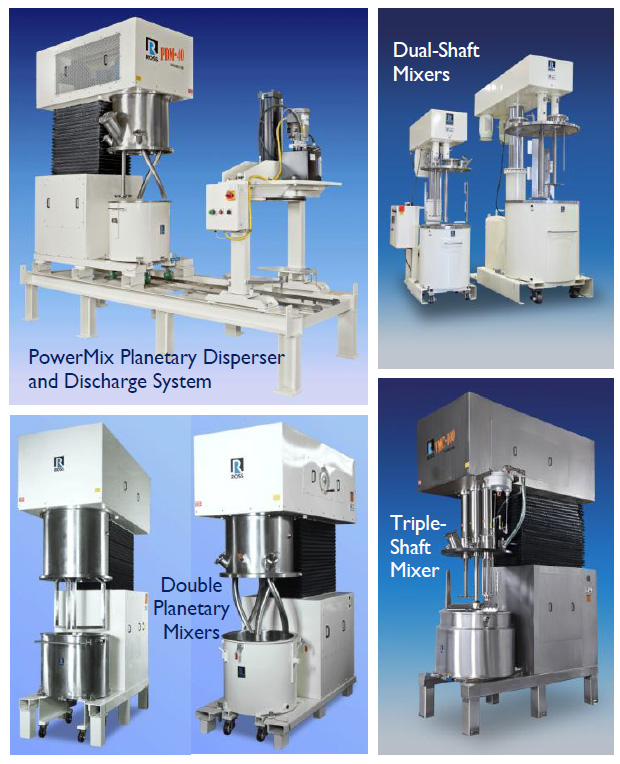Tech Report
Recommended Mixing Equipment for Urethane Sealants

Application Summary
Urethane sealants are applied in a wide variety of substrates. Different chemistries give rise to specific cure rates, bond strength, flexibility, hardness, chemical and heat resistance, vibration and sound absorption, consistency and other properties that affect sealing performance.
Accordingly, the mixing technologies utilized in the production of urethane sealants also vary from one formulation to another. Mixer selection is based on a number of factors but primarily viscosity and shear input. The starting viscosity of the resin(s) and other liquid components, the maximum viscosity reached by the mixture during processing and the final viscosity of the end product are all important considerations.
Ross Multi-Shaft Mixers and Planetary Mixers
Ross Multi-Shaft Mixers are widely used in the preparation of urethane-based sealants for construction, industrial, automotive, marine and other uses. Equipped with two or more independently-driven agitators working in tandem, Multi-Shaft Mixers deliver a robust combination of high shear agitation and laminar bulk flow within a wide viscosity range: from water-like to several hundred thousand centipoise.
The most economical design is the Dual-Shaft Mixer which features a low-speed anchor agitator and a high-speed saw-tooth disperser blade. A typical Triple-Shaft Mixer would have an additional high shear rotor/stator assembly or a second disperser shaft. These mixers are known for their processing flexibility which results mainly from the independently-controlled drives - the agitators can be engaged in any combination and at any speed setting for any interval during the mixing cycle. In fact, this feature enables vacuum-rated Multi-Shaft Mixers to often double as reactors. At one sealant production plant, for instance, the pre-polymer reaction is being done in a 300-gallon Ross Triple-Shaft Mixer. Upon completion, the necessary fillers, plasticizers, thixotropes and adhesion promoters are then added and mixed under deep vacuum. Total cycle time is under four hours, half of which is allocated to polymer preparation, the other half to mixing the finished product.
Urethane sealants that undergo very high viscosity peaks (above 1 million cP) are better prepared in Planetary Dispersers and Double Planetary Mixers. These mixers consist of two or more blades which rotate on their respective axes as they revolve around the mix vessel. Since the agitators continually advance into the batch they contact fresh product all the time and reduce the risk of localized overheating.
Combining a planetary stirrer with an orbiting high-speed disperser, a Ross PowerMix Planetary Disperser (US Patent No. 4,697,929) can quickly incorporate large amounts of dry ingredients into a thick starting liquid that would otherwise not flow readily in a Multi-Shaft Mixer. Each agitator in the PowerMix is independently controlled so flow patterns and shear rates are easily fine-tuned with every change in product rheology.
The classic Double Planetary Mixer, on the other hand, is ideal for extremely viscous formulations reaching as high as 6 million cP. Its agitation mechanism is relatively low speed but very thorough and does not require a minimum liquid level to properly wet-out and disperse solids. It consists of two identical planetary stirrers that impart increasing levels of shear as the batch gains viscosity. A typical batching procedure, for the most part, involves mixing and kneading a highly viscous paste or putty-like material until the desired level of dispersion is achieved. If needed, a let-down step is performed towards the end of the mix cycle. Testing is recommended to confirm the best mixing strategy and equipment for a particular urethane sealant formulation.
- Battery Slurries
- Binder Solutions
- Ceramic Dispersions
- Conductive Inks
- Cosmetic Creams
- Electrode Materials
- Engineered Composites
- Fuel Cell Pastes
- Hot-Melt Adhesives
- Lubricants
- Medical Gels
- Pharmaceutical Pastes
- Plastisols
- RTV Sealants
- Silicone Compounds
- Solder Pastes
- Specialty Coatings
- Syntactic Foams
- Thermal Greases
